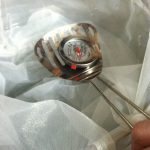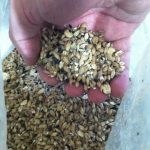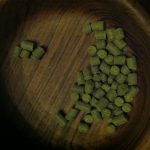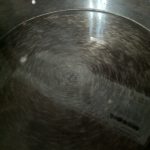One of our goals here at DrinkMatron.com is to start home brewing and bring you the results. So the first step in this is to buy the equipment needed.
Whether you’re making wine, beer, or mead, they all require the same basic set up and equipment. This is because you are essentially doing the same thing for all of them: using yeast to incite the conversion of a carbohydrate into ethyl alcohol (fermentation). The only difference is in what you’re using for a base carbohydrate: in wine you’re using grapes, in mead – honey, in beer- grain.
The following is the basic equipment needed to produce them.
Carboys

This is the storage container used to store fermenting liquid until it turns into a tasty adult beverage. You can typically get these ranging in size from 5 to 15 gallons. Most beer recipes/kits are geared around a 5 gallon batch, but wine recipes/kits are geared toward 6 gallons. So if you plan on making both wine and beer (like I do), I recommend 6 gallons. Five gallon buckets are also an option, but while they are cheaper and easier to store, they’re also harder to clean and keep sanitized. I personally prefer carboys over buckets.
You can use one carboy for the entire fermentation process, but there is a process known as the two-stage process (for obvious reasons) in which you do your fermentation in 2 vessels. There are four benefits to doing this:
- Moving the partially fermented liquid separates it from the waste by products of the yeast.
- The yeast will be exposed to oxygen, reinvigorating the fermentation process, and allowing for a more complete fermentation.
- Moving the liquid will cause any suspended solids to flocculate, or drop out, much quicker, leaving you with a cleaner product with significantly less sediment at the bottom of each bottle.
- You just freed up your primary fermentation receptacle. Start a new batch!
I, for one, like the two-stage fermentation process, so the Official Drink Matron Homebrew Laboratory will have two 6 gallon carboys.
Bung

The bung is the stopper placed in the end of the carboy to stop impurities from getting into the pre-fermented liquid and wreaking havoc on your tasty beverages. You need to make sure to get the one with the hole in it so you have a place to put your airlock. Because one of the byproducts of fermentation is carbon dioxide, using a full bung (yes it’s as funny to write as it is to read) will cause your carboy to quickly fill with carbon dioxide and, with enough pressure, literally blow its top.
Airlock

The airlock is an ingenious device that allows air through in one direction, but not the other. A three piece airlock is filled with water and as air comes in from the bottom spout into the chamber it passes through the water barrier and out the top. This gets placed in the hole in the center of the bung (not to be confused with a Bunghole – the hole in a cask, keg, or barrel through which liquid is poured in or drained) and allows for release of carbon dioxide from the fermentation process.
Tubing

You need tubing for transferring your liquid (racking) from one recepticle to another. When purchasing this tubing, you need to be sure that the diameter is the same as the diameter of the nozzles/connectors it will be attached to. You can buy connectors that will convert between diameters, but you should only do this if you have to. Otherwise, you are just wasting money on more things to wash and sanitize.
Stirring Paddle

There are a number of times throughout the fermentation process that you need to stir your concoction. Whatever you buy to do this, make sure it fits through the bunghole into the carboy. It’s best if you can get one that attaches to a drill for more thorough stirring.
Bottling Wand

This isn’t really a necessity, but bottling is a whole lot easier if you have one of these.
It works like this: During bottling, you will attach it to the end of the hose. The bottom is a plunger that stops the flow of the liquid inside. When depressed (when pushed against the bottom of the bottle) it allows the liquid to flow out and fill your bottle. Once you lift it up again, the liquid will stop flowing.
The bottling wand allows you to bottle your tasty creations without making a huge mess or having to create a siphon for every bottle.
Racking Cane

The racking cane is attached to the end of the hose and placed in the receptacle you are taking the liquid from. Again, this isn’t necessary, but very useful. It is capped on one end to prevent you siphoning off the yeast cake at the bottom of your carboy.
Stainless Steel Pot

A stainless steel pot is really only needed if you’re making beer. You’ll use it to boil all your ingredients together before starting fermentation.
The key to the perfect steel pot is to make sure that it’s big enough to hold all the liquid you need for your wort.
Wort Chiller

After boiling your wort, the key to successful beer is adding your yeast after the temperature has fallen to an appropriate level. If you wait too long, its possible that your wort can become contaminated, which may alter the taste or aroma. So the faster you cool it off, the less chance there is for fluctuation in the recipe. A wort chiller solves this very elegantly. Place the copper tubing in the pot you boiled the wort in, attach one end to the kitchen faucet and place the other end in the sink. Run cold water at the faucet until the drain water is approximately room temperature. This will take a few minutes (no more than five).
Mesh Hops Bag

For most beers, you will remove the hops from the wort before leaving it to ferment. The easiest way to do this is with a mesh bag. Most kits will come with one, but I don’t really like the bags they provide, since they’re cheap and the holes are too big. Muslin bags work much better and are only slightly more expensive.
Bottles


When your stuff is done, you have to put it in something. Beer bottles, wine bottles, kegs, mason jars, etc. Pick something, buy enough to put all your booze in, and fill ’em up!
Things to Stop Spillage


Once you put your booze in bottle, you need to stop it from spilling everywhere: cap it or cork it! Also, when you bottle your beer, the carbonation process mostly occurs after you cap the bottles.
Bottle Capper

This aptly named device is used to cap your bottles of beer. To use this you place the cap on top of the bottle, place this on top and push down the handles.
Bottle Corker

There are many types of corkers you can buy. I prefer the floor corker because I don’t like to work up a sweat and be sore after bottling all my booze.
Copyright of Drinkmatron.com. Contact website admin to obtain permission for republication.
 Brooklyn Brew Shop
Brooklyn Brew Shop Midwest Supplies
Midwest Supplies
























